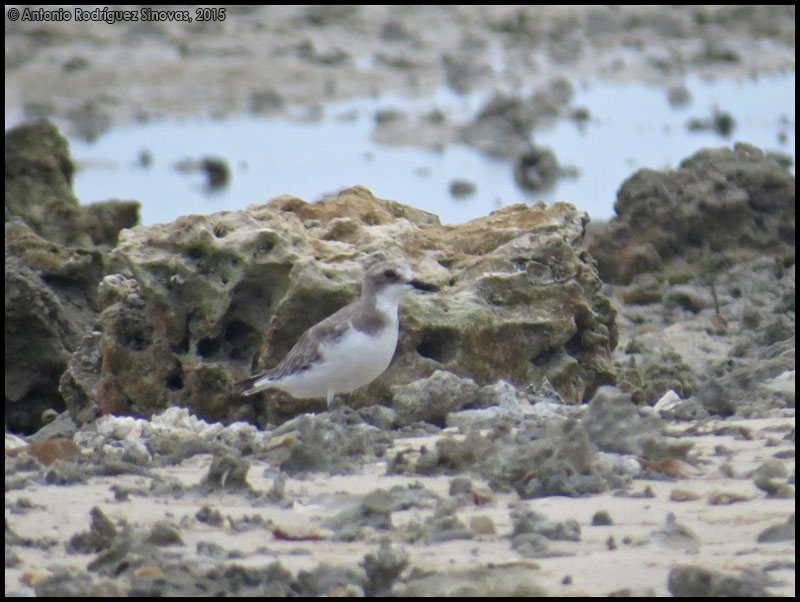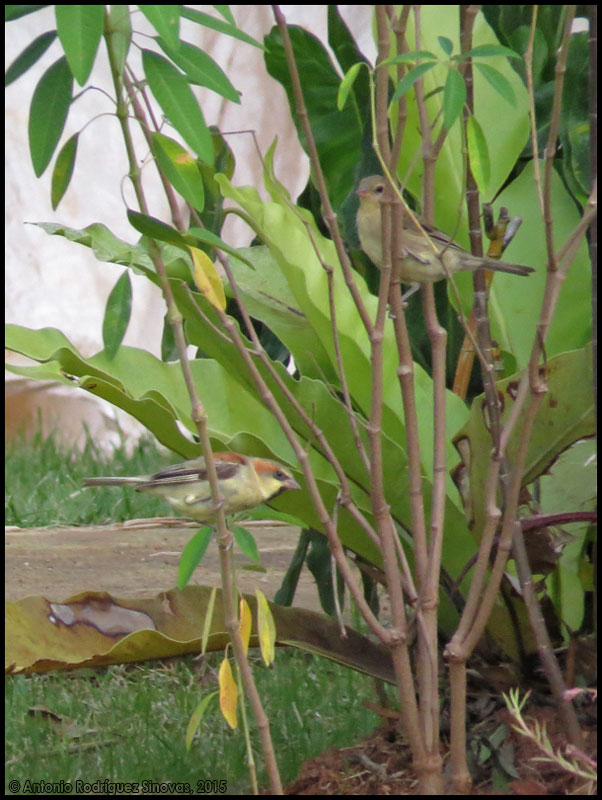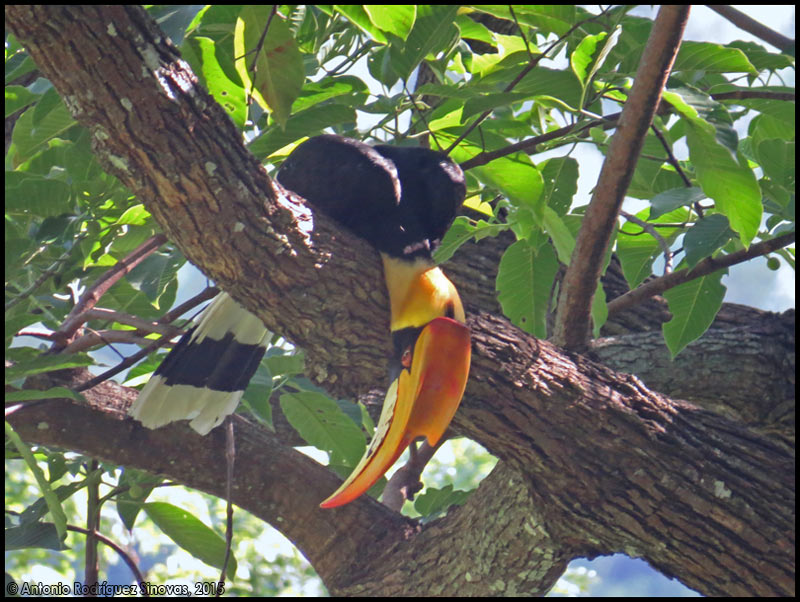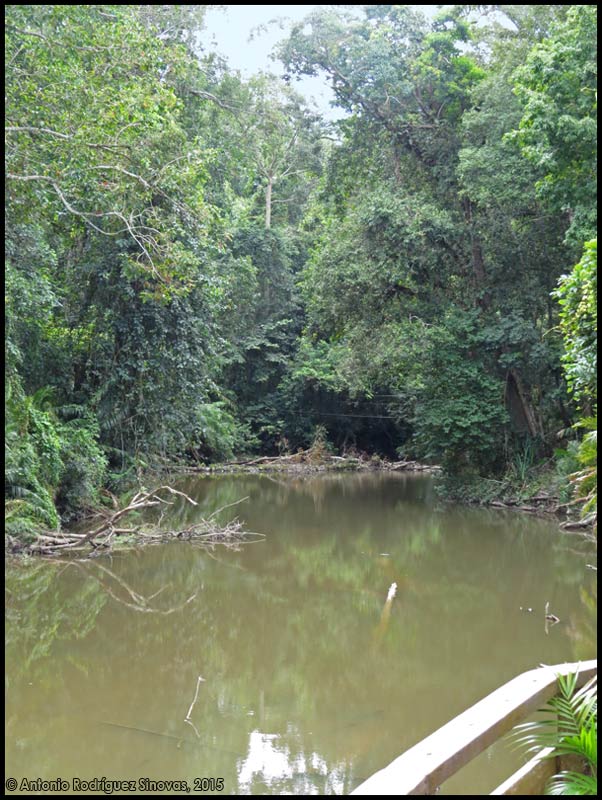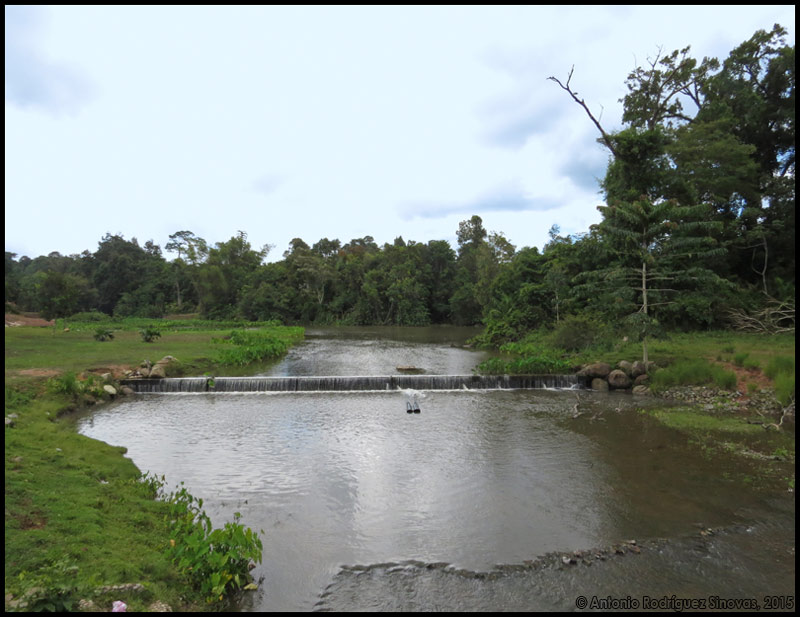La crónica de viaje de eBird, junto con el mapa de las principales zonas visitadas y la lista de aves observadas en Tailandia, puede encontrarse en este
enlace.
The eBird trip report, showing a map with the main visited locations, together with the complete list of bird species seen in Thailand, can be seen in this link.
Recorrido por Tailandia
Y por fin, tras pasar por Lopburi, llegamos a la visita más interesante desde el punto de vista del naturalista: el parque nacional Khao Yai. El parque incluye bosque lluvioso siempreverde y zonas de herbazales. Khao Rom, con 1.351 m de altitud es el pico más alto dentro del parque, cuya altitud media oscila entre los 400 y los 1000 m sobre el nivel del mar. Para información ornitológica sobre este o cualquier otro lugar de Tailandia recomiendo visitar al web de
Thaibirding. Nos alojamos durante 4 noches en el Khao Yai Cottage, un establecimiento muy sencillito situado en la entrada norte del parque. Ya en los jardines del hotel, y en los campos cercanos se podían ver un sinfín de especies de aves. Eso sí, aunque estuvimos 3 días enteros visitando el parque, los únicos elefantes que vimos fueron algunos domésticos.
And finally, after Lopburi, we arrived to the most interesting visit for the naturalist: the Khao Yai National Park. It includes rain/evergreen forests and grasslands. 1,351 m high Khao Rom is the highest mountain within the park. The average altitude of the national park ranges from 400 to 1000 m above the sea level. For ornithological information about this park or any other area in Thailand, I recommend to visit the web site Thaibirding. Our accomodation was in the Khao Yai Cottage, where we spent 4 nights. In our hotel gardens and in the fields around it, it was possible to see a good number of bird species. On the other hand, despite we spent three full days in the park, the only elephants that we were able to see, where domestic ones.
Sastrecillo común / Common tailorbird (Orthotomus sutorius)
Gorrión liso / Pegu sparrow (Passer flaveolus)
Cethosia cyane
Elefante asiático / Asian elephant (Elephas maximus) (doméstico)
Capuchino Culiblanco / White-rumped munia (Lonchura striata)
Iora común / Common iora (Aegithina tiphia)
Barbudo calderero / Coppersmith barbet (Psilopogon haemacephalus)
Miná Religioso / Common hill myna (Gracula religiosa)
Cotorra pechirroja / Red-breasted parakeet (Psittacula alexandri)
Vinago piquigrueso / Thick-billed green-pigeon (Treron curvirostra)
Neurothemis fulvia
En este parque me di cuenta de lo difícil que es localizar la fauna en lugares selváticos. Si no llega a ser por el guía que contratamos, de la empresa TonTan Travel, nos quedamos sin ver nada (finalmente vimos 61 especies de aves). El parque tiene pocas rutas que puedas hacer tú sólo, y las que hay están mal indicadas. Así que la primera vez sí recomiendo ir guiados. Hay que estar atentos desde la carretera, ya que es posible ver algunas de las estrellas del parque, como el cálao bicorne o los gibones de manos blancas (primero oídos que vistos).
Visiting this park I have noticed the difficulties of watching wildlife within the jungle. However, and thanks to our guide, from the TonTan Travel company, we managed to see a good number of species (finally we saw 61 bird species). The parks has few trails, and indications are poor. Thus, I recommend to hire a guide. From the road you have to pay attention, as it is possible to see some of the stars of the park, as great hornbills and lar gibbons (first heard than seen).
Plano del Khao Yai National Park
Khao Yai National Park, Km30 Viewpoint
Cálao bicorne / Great hornbill (Buceros bicornis)
Cálao bicorne / Great hornbill (Buceros bicornis)
Gibón de manos blancas / Lar gibbon (Hylobates lar)
Gibón de manos blancas / Lar gibbon (Hylobates lar)
Gibón de manos blancas / Lar gibbon (Hylobates lar)
Oriental whip snake (Ahaetulla prasina)
En el centro de visitantes hay una ruta cortita, circular, y de poca duración que se puede hacer sin necesidad de guía y que merece la pena como una primera aproximación al parque. Pudimos ver, entre la ruta y los alrededores del centro, macaco de cola de cerdo septentrional, sambar y algunas especies de aves.
In the visitor center there is a short round trail that allow you to have an idea about the park. You can do it with no guide. Here, in the trail and in the area around the visitor center, we saw northern pig-tailed macaque, sambar and some bird species.
Khao Yai National Park, Visitor center
Khao Yai National Park, Visitor center-Kong Kaew Waterfall Nature Loop Trail
Sambar (Rusa unicolor)
Cormorán de Java / Little cormorant (Microcarbo niger)
Water monitor (Varanus salvator)
Yellow-headed temple turtle (Heosemys annandalii)
Macaco de cola de cerdo septentrional / Northern pig-tailed macaque (Macaca leonina)
Hypolimnas missipus
El Nong Pak Chi Trail (que empieza en el Km.33 de la carretera, ruta 3 en el mapa) es una ruta interesante, que atraviesa primero la jungla, para luego llegar a un herbazal que rodea un pequeño lago con una torre de observación. Es buena zona para ver mamíferos, aunque aquí no tuvimos suerte, más allá de gibones. Eso sí, más cálaos, pito nuquigualo y bastantes más especies de aves.
The Nong Pak Chi Trail (that departs from Km. 33, trail 3 in the map) is interesting. This trail crosses the jungle to arrive to a grassland around a pond, with an observation tower. It is a good spot to see mammals, although we only saw gibbons. But a good number of birds, including more hornbills, greater yellownape and more.
Khao Yai National Park, Ruta 3-Km33-Nong Pak Chi Trail
Khao Yai National Park, Ruta 3-Km33-Nong Pak Chi Trail
Khao Yai National Park, Ruta 3-Km33-Nong Pak Chi Trail
Khao Yai National Park, Ruta 3-Km33-Nong Pak Chi Trail
Trogón cabecirrojo / Red-headed trogon (Harpactes erythrocephalus)
Pito nuquigualdo / Greater yellownape (Chrysophlegma flavinucha)
Abejaruco barbiazul / Blue-bearded bee-eater (Nyctyornis athertoni)
Identificación pendiente (Familia Harpagophoridae)
Identificación pendiente
Identificación pendiente
En la zona del Lumtakonk Campsite comimos dos días. Aquí se ven varios sambar, junto con otras especies, como picotenaza asiático.
In the area around Lumtakonk Campsite we had lunch two of the days. Here there are several sambar, and other species as asian openbill.
Khao Yai National Park, Lumtakonk Campsite
Sambar (Rusa unicolor)
Water monitor (Varanus salvator)
El Pha Diew Die Viewpoint es una zona interesante para intentar ver más cálaos. Aquí no los vimos, pero sí algunos pícidos y barbudos. En ruta algún muntiaco rojo y ardillas variables.
The Pha Diew Die Viewpoint is an interesting area to try to see more hornbill. Here we did not see them, but we managed to see some woodpeckers and barbets. In the route, we saw some red muntjacs and variable squirrels.
Khao Yai National Park, Pha Diew Die Viewpoint
Khao Yai National Park, Pha Diew Die Viewpoint
Barbudo bigotudo / Moustached barbet (Psilopogon incognitus)
Muntiaco de India / Northern red muntjac (Muntiacus vaginalis)
Ardilla variable / Variable squirrel (Callosciurus finlaysonii)
Dirección a la Haew Narok Waterfall vimos un grupo de macacos de cola de cerdo septentrional.
In the route to the Haew Narok Waterfall we saw some northern pig-tailed macaques.
Khao Yai National Park, Haew Narok Waterfall
Macaco de cola de cerdo septentrional / Northern pig-tailed macaque (Macaca leonina)
Orange-winged flying lizard (Draco maculatus)
Agama versicolor / Eastern garden lizard or Changeable lizard (Calotes versicolor)
Water monitor (Varanus salvator)
Identificación pendiente
Y en la Haew Suwat Waterfall me sorprendió una especie que ya conocía, un par de lavanderas cascadeñas.
And in the Haew Suwat Waterfall I saw a bird species that I knew from Europe, two grey Wagtails.
Khao Yai National Park, Haew Suwat Waterfall
Lavandera cascadeña / Grey wagtail (Motacilla cinerea)
Vogel's pit viper (Trimeresurus vogeli)
Papilio nephelus
Eurema spp.
Buscando entre los herbazales también me sorprendieron varios elanios comunes, que también es posible observar en el sur de España.
And looking over the grasslands, it was possible to see also some black-winged Kite, a raptor species present also in south Spain.
Khao Yai National Park, Hacia Pha Diew Die Viewpoint
Elanio común / Black-winged kite (Elanus caeruleus)
Junonia orithya
Neptis spp.
Lista de aves observadas / Bird species observed:
Red Turtle-dove - Streptopelia tranquebarica - Tórtola cabecigrís - X
Zebra Dove - Geopelia striata - Tortolita estriada - 5
Thick-billed Green-pigeon - Treron curvirostra - Vinago piquigrueso - 8
Asian Palm-swift - Cypsiurus balasiensis - Vencejo palmero asiático - X
House Swift - Apus nipalensis - Vencejo oriental - 4
Greater Coucal - Centropus sinensis - Cucal chino - 3
Green-billed Malkoha - Phaenicophaeus tristis - Malcoha sombrío - 1
Asian Openbill - Anastomus oscitans - Picotenaza asiático - 3
Cattle Egret - Bubulcus ibis - Garcilla bueyera - 1
Little Egret - Egretta garzetta - Garceta común - 2
Little Cormorant - Microcarbo niger - Cormorán de Java - 4
Red-wattled Lapwing - Vanellus indicus - Avefría india - X
Spotted Owlet - Athene brama - Mochuelo brahmán - 1
Black-winged Kite - Elanus caeruleus - Elanio común - 4
Crested Serpent-eagle - Spilornis cheela - Culebrera chiíla - 1
Mountain Hawk-eagle - Nisaetus nipalensis - Águila montañesa - 1
Shikra - Accipiter badius - Gavilán chikra - 2
Red-headed Trogon - Harpactes erythrocephalus - Trogón cabecirrojo - 1
Great Hornbill - Buceros bicornis - Cálao bicorne - 4
Blue-bearded Bee-eater - Nyctyornis athertoni - Abejaruco barbiazul - 2
Oriental Dollarbird - Eurystomus orientalis - Carraca oriental - 8
Coppersmith Barbet - Psilopogon haemacephalus - Barbudo calderero - x
Green-eared Barbet - Psilopogon faiostrictus - Barbudo orejiverde - 1
Lineated Barbet - Psilopogon lineatus - Barbudo listado - 1
Moustached Barbet - Psilopogon incognitus - Barbudo bigotudo - 2
Greater Flameback - Chrysocolaptes guttacristatus - Pito sultán grande - 1
Greater Yellownape - Chrysophlegma flavinucha - Pito nuquigualdo - 1
Laced Woodpecker - Picus vittatus - Pito colinegro - 1
Vernal Hanging-parrot - Loriculus vernalis - Lorículo vernal - 1
Red-breasted Parakeet - Psittacula alexandri - Cotorra pechirroja - X
Barn Swallow - Hirundo rustica - Golondrina Común - X
Grey Wagtail - Motacilla cinerea - Lavandera Cascadeña - 2
Black-headed Bulbul - Pycnonotus atriceps - Bulbul Cabecinegro - 3
Black-crested Bulbul - Pycnonotus flaviventris - Bulbul Crestinegro - 6
Red-whiskered Bulbul - Pycnonotus jocosus - Bulbul Orfeo - 4
Sooty-headed Bulbul - Pycnonotus aurigaster - Bulbul Ventridorado - 7
Yellow-vented Bulbul - Pycnonotus goiavier - Bulbul Culiamarillo - 1
Streak-eared Bulbul - Pycnonotus blanfordi - Bulbul de Blanford - 6
Asian Fairy-bluebird - Irena puella - Irena Dorsiazul - 2
Common Iora - Aegithina tiphia - Iora Común - 2
Oriental Magpie-robin - Copsychus saularis - Shama Oriental - 7
Pied Bushchat - Saxicola caprata - Tarabilla Pía - 1
Black-naped Monarch - Hypothymis azurea - Monarca Nuquinegro - 3
Common Tailorbird - Orthotomus sutorius - Sastrecillo Común - 7
Dark-necked Tailorbird - Orthotomus atrogularis - Sastrecillo Cuellinegro - 1
White-crested Laughingthrush - Garrulax leucolophus - Charlatán Crestiblanco - 3
Sultan Tit - Melanochlora sultanea - Carbonero Sultán - 2
Olive-backed Sunbird - Cinnyris jugularis - Suimanga Dorsioliva - 1
Little Spiderhunter - Arachnothera longirostra - Arañero Chico - 1
Black-hooded Oriole - Oriolus xanthornus - Oropéndola Encapuchada - 2
Greater Racket-tailed Drongo - Dicrurus paradiseus - Drongo de Raquetas Grande - 2
Hair-crested Drongo - Dicrurus hottentottus - Drongo Crestudo - 2
Ashy Woodswallow - Artamus fuscus - Artamo Ceniciento - X
Large-billed Crow - Corvus macrorhynchos - Cuervo Picudo - 2
Common Hill Myna - Gracula religiosa - Miná Religioso - 3
Great Myna - Acridotheres grandis - Miná Grande - X
Common Myna - Acridotheres tristis - Miná Común - X
Pegu Sparrow - Passer flaveolus - Gorrión Liso - 3
Eurasian Tree Sparrow - Passer montanus - Gorrión Molinero - X
Scaly-breasted Munia - Lonchura punctulata - Capuchino Punteado - X
White-rumped Munia - Lonchura striata - Capuchino Culiblanco - 5
Lista de mamíferos observados / Mammal species observed:
Lar gibbon - Hylobates lar - Gibón de manos blancas - 12
Northern pig-tailed macaque - Macaca leonina - Macaco cola de cerdo septentrional - X
Sambar - Rusa unicolor - Sambar - X
Red muntjac - Muntiacus muntjak - Muntiaco rojo - 3
Variable squirrel - Callosciurus finlaysonii - Ardilla variable - 2
Asian wrinkle-lipped bat - Caerephon plicatus - X















